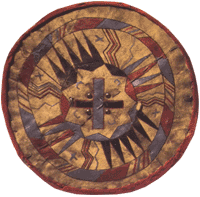





The Aztecs were a Mesoamerican people of central Mexico in the 14th, 15th and 16th century. It was a tribe with a rich mythology and cultural heritage. Their capital was Tenochtitlan on the shore of Lake Texcoco – the site of modern-day Mexico City.
In Nahuatl, the native language of the Aztecs, "Aztec" means "someone who comes from Aztlán", a mythical place in northern Mexico. However, the Aztec referred to themselves as Mexica (IPA [me'?ihkah]) or Tenochca. The modern usage of the name Aztec as a collective term, applied to all the peoples linked by trade, custom, religion, and language to the Mexica state, the Triple Alliance, was suggested by Alexander von Humboldt.
"Mexica", the origin of the word Mexico, is a term of uncertain origin. Some say it was the old Nahuatl word for the sun. Others say it was derived from the name of their leader Mexitli. Yet others say it is just a type of weed that grows in Lake Texcoco. Miguel León-Portilla suggests that it means "navel of the moon" from Nahuatl metztli (moon) and xictli (navel). Alternatively, it could mean navel of the maguey (Nahuatl metl).
Aztec culture is generally grouped with the cultural complex known as the nahuas, because of the common language they shared. According to legend, the various groups who were to become the Aztecs arrived from the north into the Anahuac valley around Lake Texcoco. The location of this valley and lake of destination is clear – it is the heart of modern Mexico City – but little can be known with certainty about the origin of the Aztecs.
In the legend, the ancestors of the Aztecs came from a place in the north called Aztlán, the last of seven nahuatlacas (Nahuatl-speaking tribes) to make the journey southward. The Aztecs were said to be guided by their god Huitzilopochtli, meaning "Left-handed Hummingbird".
When they arrived at an island in the lake, they saw an eagle eating a snake while perched on a nopal cactus, a vision that fulfilled a prophecy telling them that they should found their new home on that spot. The Aztecs built their city of Tenochtitlan on that site, building a great artificial island, which today is in the center of Mexico City. This legendary vision is pictured on the Mexican flag.
According to legend, when the Aztecs arrived in the Anahuac valley around Lake Texcoco, they were considered by the other nahuas as the least civilized of all, but the Aztecs decided to learn, and they took all they could from other peoples, especially from the ancient Toltecs (whom they seem to have partially confused with the more ancient civilization of the Teotihuacanos). To the Aztecs, the Toltecs were the originators of all culture; "Toltecayotl" was a synonym for culture. Aztec legends identify the Toltecs and the cult of Quetzalcoatl with the mythic city of Tollan, which they also seem to have identified with the more ancient Teotihuacan.
Because the Aztecs combined several traditions with their own earlier traditions, they had several creation myths; one of these describes four great ages preceding the present world, each of which ended in a catastrophe. Our age – Nahui-Ollin, the fifth age, or fifth creation – escaped destruction due to the sacrifice of a god (Nanahuatl, "full of sores", the smallest and humblest of the gods) who was transformed into the Sun. This myth is associated with the ancient city of Teotihuacan, which was already destroyed when the Aztecs arrived. Another myth describes the earth as a creation of the twin gods Tezcatlipoca and Quetzalcoatl. Tezcatlipoca lost his foot in the process of creating the world and all representations of these gods show him without a foot and with a bone exposed. Quetzalcoatl is also called "White Tezcatlipoca".
